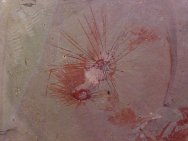Name: Choia utahensis and Unkown (Kingdom: Animalia; Phylum: Porifera; Class: Demospongia; Subclass: Ceractinomorpha; Order: Monaxida; Family: Choiidae; Genus: Choia)
Age: Middle Cambrian Utah Cambrian Explosion Fossils
Size (25.4mm=1 inch): Matrix 7 3/8" X 6 3/4" ( 190mm X 175mm) Largest Choia 1 3/4" (45mm), unkown fossil 3 1/8" (80mm)
Location: Wheeler Shale, Millard County, Utah
|
Choia is a rarer genus of sponge (Phylum Profera) with radiating spines, and is also found in the Burgess Shale. This plate was found in the Wheeler Shale’s so-called 'red beds', as the plate’s color attests. This is an excellent specimen of two very different organisms from the Cambrian Explosion with rare preservation and very nice contrast. Sponge fossils from the Cambrian Explosion are found in various Cambrian sites in North America, most notably the Burgess Shale of Canada, and the Cambrian strata of Utah, like this specimen. Many sponges are also described from the Chengjiang biota of China. Sponges are believed to have undergone repeated radiations in the Phanerozoic, and probably attained their largest diversity in the Cretaceous. Rigby, J.K. (1983). Sponges of the Middle Cambrian
Marjum Limestone from the House Range and Drum Mountains of western
Millard County, Utah. Journal of Paleontology 57, 240-270. |



